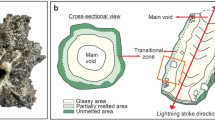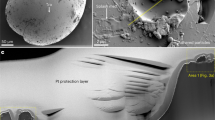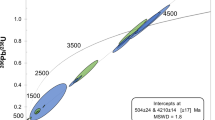Abstract
VARIOUS authors1–4 have shown that transient lunar phenomena (TLPs) are unlikely to arise from the excitation of luminescence in lunar rocks by such agents as the solar wind5, but the luminescent efficiency is many orders of magnitude too low for this emission to be detected even by “line fill” techniques6. To see an effect against the normal moonlight a contrast brightness change of at least 10% is necessary representing an incremental light flux from the surface of the order of 10−2 W cm−2. The most likely cause of such a change is a change in the albedo. The low albedo of about 7% is a factor of 2 or 3 times lower than that of a terrestrial basaltic dust of similar composition. This is because of the “fairy castle” structure of the lunar dust, giving deep intergrain penetration of sunlight and little return except in the incidence direction. If this structure could be destroyed by breaking of the intergrain cohesion, then the albedo would rise. This could be achieved if the dust was “fluidized”. Such a process has already been associated with TLPs by Mills7 but he assumes that the TLP is seen because of the light emission caused by electrical discharges in the venting gases between grains. But the efficiency of excitation of such discharges will be rather low and the same kind of estimate as that made by Nash et al.3 for the luminescence of lunar dust will apply.
This is a preview of subscription content, access via your institution
Access options
Subscribe to this journal
Receive 51 print issues and online access
$199.00 per year
only $3.90 per issue
Buy this article
- Purchase on Springer Link
- Instant access to full article PDF
Prices may be subject to local taxes which are calculated during checkout
Similar content being viewed by others
References
Moore, P., J. Brit. Astron. Assoc., 81, 365 (1971).
Geake, J. E., Dollfus, A., Garlick, G. F. J., Lamb, W. E., Walker, G., Steigmann, G. A., and Titulaer, C., Proc. Apollo 11 Lunar Sci. Conf., 2127 (Pergamon, New York, 1970).
Nash, D. B., and Greer, R. T., Proc. Apollo 11 Lunar Sci. Conf., 2341 (Pergamon, New York, 1970).
Blair, I. M., and Edgington, J. A., Proc. Apollo 11 Lunar Sci. Conf., 2001 (Pergamon, New York, 1970).
Kopal, Z., and Rackham, T., Icarus, 2, 481 (1963).
Grainger, J. F., and Ring, J., Proc. Intern. Space Sci. Symp., 989 (1963).
Mills, A. A., Nature, 225, 929 (1970).
Author information
Authors and Affiliations
Rights and permissions
About this article
Cite this article
GARLICK, G., STEIGMANN, G. & LAMB, W. Explanation of Transient Lunar Phenomena based on Lunar Samples Studies. Nature 235, 39–40 (1972). https://doi.org/10.1038/235039a0
Received:
Revised:
Issue Date:
DOI: https://doi.org/10.1038/235039a0
This article is cited by
-
Effect of Fluidization on the Polarization of Reflected Light from Lunar Dust Layers
Nature Physical Science (1972)
Comments
By submitting a comment you agree to abide by our Terms and Community Guidelines. If you find something abusive or that does not comply with our terms or guidelines please flag it as inappropriate.



